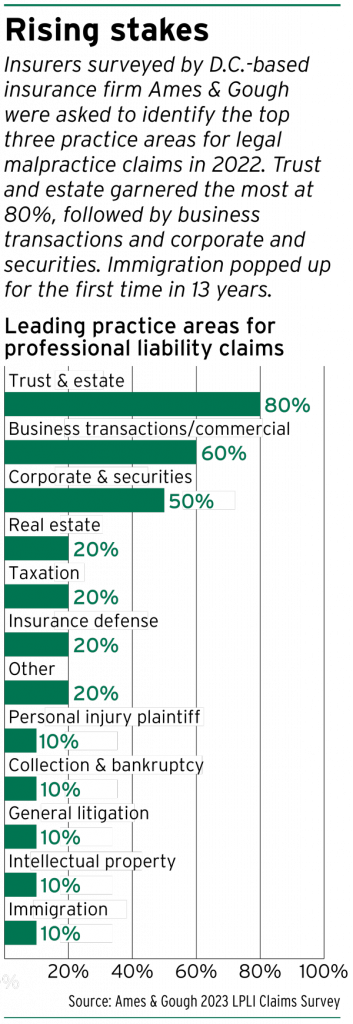Subscriber Benefit
As a subscriber you can listen to articles at work, in the car, or while you work out. Subscribe NowEven as the number of legal malpractice claims has remained relatively flat, the severity of those claims continues to climb, with costlier mistakes and social inflation serving as two key factors driving the rise.
That’s according to a survey of 10 leading insurance companies that write lawyers’ professional liability insurance coverage.
The survey, conducted by D.C.-based insurance firm Ames & Gough, found six insurance providers reported a similar frequency in claims in 2022 compared to 2021. Two providers reported a higher frequency of claims, and the other two providers reported a lower frequency.
But the number of claims resulting in multimillion-dollar payouts has increased year over year, the survey found.
Three of the 10 insurers had paid a claim of more than $100 million in the last two years, and two others paid a claim between $150 and $300 million.

Eileen Garczynski, senior vice president and partner at Ames & Gough, said reasons for an increase in claim severity include that the cost to defend cases has gone up and claims are becoming increasingly sophisticated.
“It takes more expertise,” she said.
Another reason for the increase, Garczynski said, is that there are more high-stakes cases that include sophisticated deals and big mergers.
“I think it’ll just continue to get more complicated,” she predicted.
‘A lack of diligence and energy’

Bob Nice, managing partner at The Nice Law Firm LLP in Indianapolis, is a plaintiff’s legal malpractice attorney. He started that work more than 25 years ago and said it’s almost all he does these days.
Nice said some of the common problems that generate malpractice claims include bad documents in business transactions, missing deadlines, failing to contemplate something in estate planning and other similar errors.
“Usually,” he said, “it’s just a lack of diligence and energy.”
Nice said in his opinion, it takes about 10 years of mentoring before an attorney is good enough to work from the beginning of a case to the end on their own. And he’s worried that isn’t happening in today’s law offices.
 “The work ethic today — I’m painting with a broad brush — isn’t what it was 30, 35 years ago,” he said.
“The work ethic today — I’m painting with a broad brush — isn’t what it was 30, 35 years ago,” he said.
Another issue Nice identified is lawyers who think they can “dabble” in another practice area, which he said gets more and more difficult as complexity around the law increases.
Nice used the example of writing a will.
When he started as an attorney 38 years ago, Nice said a will might be a page or two — something much simpler than you’ll likely find today.
And as the baby boomer generation gets older, there’s more money at stake.
“When mistakes are made, they’re more significant,” Nice said.
Trust and estate was the practice area at the top of the list for insurers that were asked to identify the top three practices for claims as part of the Ames & Gough survey. That’s been true in recent years, with business transactions and corporate and securities trailing closely.
One reason identified in the survey as a reason for trust and estate’s prominence in legal malpractice claims is the duty to avoid conflicts of interest.
“Failure to manage these conflicts can lead to accusations of favoritism, bias, or breaches of fiduciary duty,” the survey says.
The survey includes recommendations such as maintaining “rigorous” procedures to check conflicts of interest and making sure there’s a “strong disclosure” in the engagement process regarding who the client is.
Garczynski said conflicts of interest is always the No. 1 claim for mid- to large-sized firms.
And the reason trust and estate has taken over the last few years as the top practice area for claims, she said, is because of a combination of the pandemic and aging baby boomers — extra deaths, in other words.
“Those two things kind of collided,” she said.
Immigration claims up slightly
Tucked away in the survey’s results is the fact that one insurer identified immigration as a practice area garnering more malpractice claims. Immigration didn’t make the list for any of the previous 12 years the survey had been conducted.
Garczynski said immigration claims may have ticked up slightly for a similar reason practice areas like trust and estate see so many claims.
“The stakes are just higher,” she said, “because it’s more personal.”
The survey also cited the complexity of immigration law, increased scrutiny and high demand.
The U.S. Government Accountability Office reported in October that there are more than 2 million cases pending in immigration courts — more than triple than at the start of fiscal year 2017.

Sarah Burrow, an immigration attorney with Lewis Kappes in Indianapolis, said one possible explanation for the uptick in claims has to do with the controversial process of filing a motion to reopen.
In filing a Lozada motion — from Matter of Lozada, 19 I&N Dec. 637 (BIA 1988) — one requirement is that the motion has to say whether a bar complaint has been filed with respect to any violation of counsel’s ethical or legal responsibilities.
If there is no complaint filed, the motion has to explain why.
Burrow said that’s created a situation where immigration attorneys are filing bar complaints against each other.
“It creates some ripples among attorneys,” she said.
Burrow also said she sees a similar reason for potential malpractice claims as what Nice identified: attorneys who think they can dabble in the field.
“I wish people would stop trying to dabble,” she said of immigration law. “It’s intricate and complex and very easily misunderstood.”
And dabbling is too common, Burrow said.
“If I could shut that down,” she said, “I would.”•
Please enable JavaScript to view this content.
